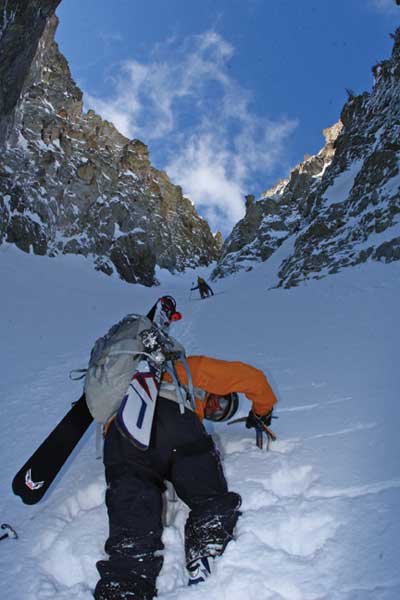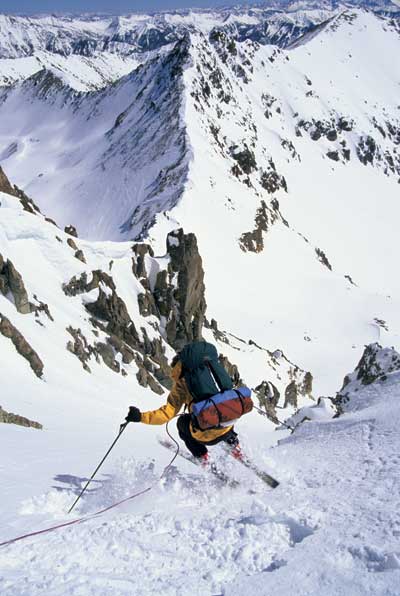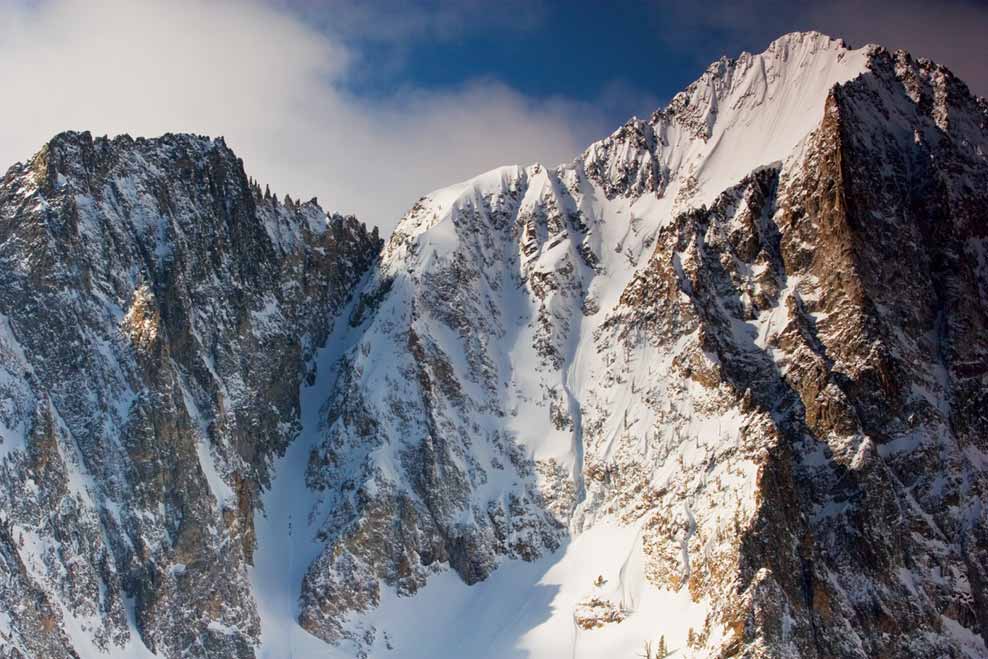| Masters of the Steep
Local ski mountaineers descend pitches that resemble elevator shafts, and that’s after climbing a mountain.
Greg Moore discovers how they do it.
Chris Lundy had fantasies about skiing The Shield, a 50-degree slope that dominates the northeast face of Horstman Peak in the Sawtooth Mountains, every time it came into view as he skied into the Williams Peak yurt. But like others with the same idea, Lundy had been put off by the unskiable cliff band that stretches across the middle of the slope. “It’s just hanging out there above this stuff that you’re not sure how you’re going to get through,” he says. “But the more I started to see it on good snow years, the more it looked like there was a possible line.”
Lundy, a soft-spoken 34-year-old, works as lead avalanche forecaster at the Sawtooth National Forest Avalanche Center in Ketchum. In April 2008, he persuaded two friends from his former home of Bozeman, Montana, to join him in an attempt on The Shield. After an exhausting, eight-hour climb up the backside of the mountain, the team reached the summit. Lundy was the first to drop into the pitch. On his initial turn, he broke a pole. Clinging to the snowfield with the edges of his skis, he pulled a splint from his pack and repaired the pole. One by one, the three carefully skied the 1,000 or so vertical feet to the cliff. They gingerly side-stepped through the rock bands, rappelled 20 feet to a point where they were back on snow, and finished the run.
The route was one of the few remaining unplucked plums of local ski mountaineering. “That was a pretty big deal,” says Eric Leidecker, co-owner with Kirk Bachman of Stanley-based Sawtooth Mountain Guides. “People had been looking at it for years.”
Ski mountaineering—distinguished from basic backcountry skiing by the use of technical climbing gear—has increased in popularity since the sport’s local pioneers began setting tracks on steep chutes in the late 1970s. Viewed from the top of Bald Mountain, the prominent peaks in the Boulder and Pioneer mountains look like impossible-to-ski jumbles of cliffs and nearly vertical snow faces. But local practitioners say every one of them has been skied.
The lines most sought after by these addicts of the steep are in the Sawtooths, a range out of sight from Baldy to the north. Drew Pogge, editor of Backcountry magazine, calls the Sawtooths “an ideal ski mountaineering range … infamous for their wealth of tight, steep couloirs and extremely exposed faces.”
Unlike mid-winter backcountry skiers, ski mountaineers aren’t searching for fresh powder. On a great powder day, the runs they ski are too avalanche prone. As such, ski mountaineering is primarily a spring sport. However, most couloirs in the Sawtooths face north, and rarely develop the spring corn snow that southern exposures do. In any case, Leidecker says, skiing a steep run on corn snow is dangerous—a fall can easily turn into an out-of-control slide. For him, perfect conditions are “chalky, settled powder.” In that kind of snow, he says, “you can do a hip check, you can get in the back seat a little bit and be able to recover.” Leidecker says a technique adaptation for skiing steep chutes is the pedal-hop turn, initiating the turn off the uphill ski. “It allows you to cross the fall line without falling down the slope too far.”
Equipment used for ski mountaineering can include an ice axe for safety while climbing, a rope, a climbing harness to attach it to, crampons and a helmet. The rope is used for rappelling unskiable sections or for belaying a skier into the top of a potentially avalanche-prone chute.
As the sport has become more popular, descents such as Lundy’s are more widely talked about. But in the early days, most ski mountaineers just went out and quietly did their thing. Though no one kept a record of first descents, one name that often pops up in discussions of early extreme-ski runs is that of Hailey resident Kim Anderson. An amiable, energetic 53-year-old with a direct, no-nonsense gaze, Anderson says he’s skied at least 30 steep routes in local mountain ranges, most of them solo.
Growing up in Idaho’s capital city of Boise, Anderson honed his skiing skills at Bogus Basin, and spent some time on the professional freestyle circuit in the mid-1970s. He knew little about traveling in the mountains. “I met this gal at a party, and she asked me if I wanted to go backpacking. I had never been backpacking before. We went to Alice Lake [in the Sawtooths]. I started looking around and thought, ‘What a great place to bring your skis!’”
Two years later, in spring 1977, he did just that, and with two friends skied the north couloir of Mt. Heyburn. “It was this wild idea to just go do it,” he says with a laugh. “I didn’t know enough to know any better.” After about 20 descents of that same couloir, he now knows a lot. Anderson has skied all nine 12,000-foot peaks in Idaho, twice descended Grand Teton in Wyoming and, in 1984, skied the 19,700-foot Artesanraju in the Cordillera Blanca of Peru—a pyramid-shaped peak reputed to be the model for the Paramount Pictures logo. More recently, he’s turned his sights to the sparsely skied Lost River Range, east of the Wood River Valley.
Anderson, wary of avalanches, says he won’t ski some of the bowls he sees backcountry skiers filling with tracks in mid winter. He waits for spring. Even then, he says, he’d rather rely on his skiing ability to get him down hard morning snow than risk an avalanche by waiting for the snow to soften. Having to earn a living during the week, he was forced to ski in whatever conditions existed on weekends. “Usually it was gnarly conditions, but I’d ski it anyway. If it was a cool, cloudy day, it would be bulletproof. Sometimes it would be perfect corn, but that’s very unusual.”
In May, he’d ski the southern and western exposures; in June and July, he’d turn to the northern and eastern faces. Ski mountaineering, he admits, is a lot of work for just one run—“but that one run is very thrilling!”
When Lundy is asked what motivated him to ski The Shield, he thinks for a moment, then replies with a perfectly straight face, “My wife asked me that.” He then adds, “I’m definitely not an adrenaline junkie—I hate being scared. I’m driven by the adventure and the wildness of it all. If only a few people have skied something, it feels more wild.”
Local ski mountaineers emphasize that not all the steep chutes in the mountains surrounding Sun Valley are of the if-you-fall-you-die variety. They say there are plenty of exhilarating descents suitable for the typical good Baldy skier. Those include the south face of Williams Peak in the Sawtooths, the west face of Lorenzo Peak and the south face of Boulder Peak in the Boulders, and Hyndman Peak and Devil’s Bedstead in the Pioneers.
Leidecker points out that it’s not lack of skiing ability that keeps most people from attempting those runs, but lack of mountaineering experience. “If you’re comfortable in the mountains, and you’re comfortable with the climbing and you’re comfortable with ropes, then these runs don’t seem as radical as they do to someone who’s just a skier. From a climber’s point of view, these runs are easy.”
One way to learn the skills needed is through a ski mountaineering course. Ketchum resident Erik Boe, a 39-year-old financial advisor, took a four-day course with Sawtooth Mountain Guides last April. He had done quite a bit of backcountry skiing but wanted to step it up. “It was the best time I’ve ever had skiing. A little push from these guys was what I needed to realize my potential. It opened a lot of windows into what’s possible.”
Leidecker acknowledges that a lot of outdoors-oriented people in the resort area are reluctant to hire a guide, but points out that ski mountaineering is a sport to treat with caution. Anderson says it took a terrifying, 150-foot-long slide down a couloir on Grand Teton to convince him that he was mortal. Since then, he says, he’s backed off. “If you push the edge for long enough, your time will be up. It’s just a numbers game. I decided a long time ago that I want to live.”
|

Photo by Cody Doucette
fgfg

Photo by Matt Leidecker
On the third day of a traverse of the Boulder Front range, ski mountaineer Ben Brock makes some belayed hop-turns into the east couloir of Silver Peak.
|



